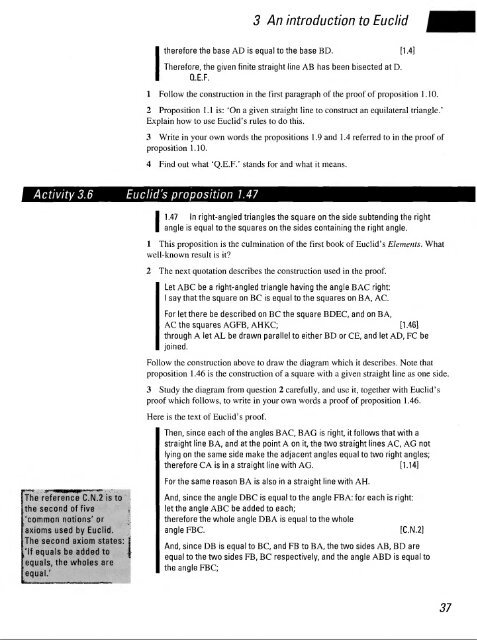history of mathematics - National STEM Centre
history of mathematics - National STEM Centre
history of mathematics - National STEM Centre
Create successful ePaper yourself
Turn your PDF publications into a flip-book with our unique Google optimized e-Paper software.
3 An introduction to Euclid<br />
therefore the base AD is equal to the base BD. [1.4]<br />
Therefore, the given finite straight line AB has been bisected at D.<br />
Q.E.F.<br />
1 Follow the construction in the first paragraph <strong>of</strong> the pro<strong>of</strong> <strong>of</strong> proposition 1.10.<br />
2 Proposition 1.1 is: 'On a given straight line to construct an equilateral triangle.'<br />
Explain how to use Euclid's rules to do this.<br />
3 Write in your own words the propositions 1.9 and 1.4 referred to in the pro<strong>of</strong> <strong>of</strong><br />
proposition 1.10.<br />
4 Find out what 'Q.E.F.' stands for and what it means.<br />
Activity 3.6 Euclid's proposition 1.47<br />
The reference C.N.2 is to<br />
the second <strong>of</strong> five<br />
'common notions' or<br />
axioms used by Euclid.<br />
The second axiom states;;!<br />
'If equals be added to III<br />
equals, the wholes are<br />
equal.'<br />
1<br />
1.47 In right-angled triangles the square on the side subtending the right<br />
angle is equal to the squares on the sides containing the right angle.<br />
1 This proposition is the culmination <strong>of</strong> the first book <strong>of</strong> Euclid's Elements. What<br />
well-known result is it?<br />
2 The next quotation describes the construction used in the pro<strong>of</strong>.<br />
Let ABC be a right-angled triangle having the angle BAC right:<br />
I say that the square on BC is equal to the squares on BA, AC.<br />
For let there be described on BC the square BDEC, and on BA,<br />
AC the squares AGFB, AHKC; [1.46]<br />
through A let AL be drawn parallel to either BD or CE, and let AD, EC be<br />
joined.<br />
Follow the construction above to draw the diagram which it describes. Note that<br />
proposition 1.46 is the construction <strong>of</strong> a square with a given straight line as one side.<br />
3 Study the diagram from question 2 carefully, and use it, together with Euclid's<br />
pro<strong>of</strong> which follows, to write in your own words a pro<strong>of</strong> <strong>of</strong> proposition 1.46.<br />
Here is the text <strong>of</strong> Euclid's pro<strong>of</strong>.<br />
Then, since each <strong>of</strong> the angles BAC, BAG is right, it follows that with a<br />
straight line BA, and at the point A on it, the two straight lines AC, AG not<br />
lying on the same side make the adjacent angles equal to two right angles;<br />
therefore CA is in a straight line with AG. [1.14]<br />
For the same reason BA is also in a straight line with AH.<br />
And, since the angle DBC is equal to the angle FBA: for each is right:<br />
let the angle ABC be added to each;<br />
therefore the whole angle DBA is equal to the whole<br />
angle FBC. [C.N.2]<br />
And, since DB is equal to BC, and FB to BA, the two sides AB, BD are<br />
equal to the two sides FB, BC respectively, and the angle ABD is equal to<br />
the angle FBC;<br />
37
















